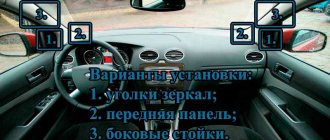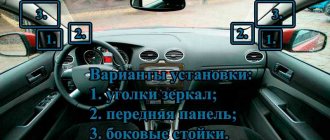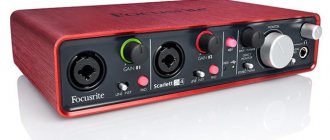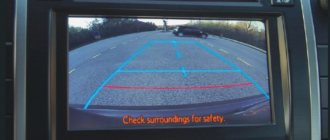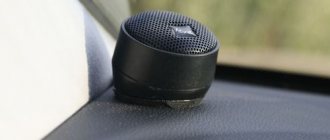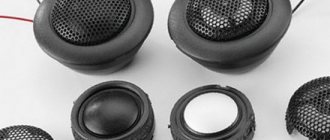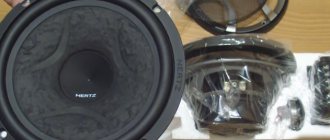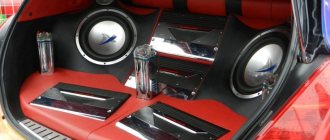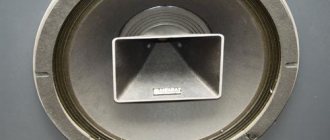Every motorist wants his car to be comfortable and convenient. One of the comfort elements that makes it more pleasant to be in a car is music. Therefore, car owners are trying in every possible way to improve the audio system and install a variety of additional equipment. One of the elements that helps improve sound is speakers and a high-quality audio system. Among the variety of systems, there are speakers called tweeters or tweeters, which are installed in addition to acoustics or separately. But not every car owner knows how to install speakers correctly and where to connect this equipment.
Tweeter in a car
Purpose
The main purpose of installing tweeters is to reproduce high frequencies. They are small speakers that are installed in the front and rear of the car (or in one of them), depending on the audio system. For maximum effect, they are used as part of multi-component audio systems, but can be found in retail sales (for example, from Pioneer). The advantages of the speakers include ease of installation - every car owner can connect the tweeters correctly.
Speakers for better sound
When installed in speaker systems, motorists install tweeters through a crossover - this is a device that provides operating ranges for the speakers. It separates frequencies when working with a multi-component audio system. This allows you to get the maximum effect from the system and ensure high-quality sound quality in the car.
Connecting tweeters to the crossover is quite simple, and to do this, you only need to read the audio system instructions. But there are times when you need to connect the tweeters in your car directly to the radio.
Connecting tweeters to the radio
Attention: installing tweeters without a crossover or other filters may affect the sound quality! The signal coming out of the radio is the same and will not be distributed across frequencies. It is not recommended to connect speakers this way, but it is possible.
It is possible to connect tweeters to speakers that are already installed. To do this, you will need a 1st order filter (capacitor). The capacity will depend on the installed speakers and is selected individually in each specific case.
Connection rules
Choosing the right high-frequency speakers (beepers, tweeters) for the car
Tweeters or tweeters are high-frequency speakers used in speaker systems. The main task of these devices is to reproduce high-frequency sounds.
Tweeters or tweeters for acoustics are usually included in a multi-component system, but they can also be purchased separately. Externally, they are small speakers, but despite this, they are able to significantly improve car sound, adding volume and sonority to it.
The price of beepers for a car starts from 200 rubles and above, depending on the brand and characteristics of the device.
The first thing you need to do when choosing a sound system for a car is to decide on high-quality component acoustics, because only its use guarantees good and rich sound. Be sure to pay attention to the power of the system; it must match the power of the amplifier.
As for which beepers for the car are better, the main thing here is the material from which their domes are made. It can be silk or metal, plastic, paper.
After purchase, it is better to install the tweeters in podiums (which you can make yourself), and soundproof the door.
Install them backwards or forwards - it all depends on the layout of the speaker system. However, keep in mind that it is not worthwhile to install tweeters yourself without certain skills, since this process is quite complex, and when installing devices of this kind, you should take into account the possibility of sound distortion caused by the effect of its reflection.
Criteria for choosing tweeters for a car
Experts do not see much difference between the performance of tweeters with silk and metal domes, since everything depends entirely on the quality with which they are made and on the company supplying them. The only significant difference is the phase equalization disk, which is only available on metal dome tweeters.
For example, among silk tweeters the highest quality and most productive tweeters are Alphard. Their cost is higher than some other devices, but the quality is noticeably better.
From metal tweeters, high-quality sound is produced by Dragster tweeters, the price of which starts from 1,500 rubles.
Features of tweeters - components of tweeters
The basis for the tweeter is a coil, which is located between the core and the magnet. It is tightly attached to a sound-emitting device - a dome-shaped membrane.
The sound emitted by the membrane occurs as follows:
Basically, tweeters come with the following membranes:
The magnets of HF speakers, regardless of whether they are expensive or cheap, are powerful neodymium.
The most common are 2 types of tweeters, which differ in design features:
How to choose the right tweeters
Tweeters are an important component of any car audio system. They are available for purchase at almost every electronics store. When buying these devices, be sure to pay attention to 3 parameters:
Video: what is a crossover and how to choose tweeters.
The use of other parameters in the selection of tweeters is possible, but it is not so important and rather corresponds to the personal wishes and financial capabilities of the car enthusiast, as well as the technical characteristics of the car.
Source
Requirements before connecting
To properly install tweeters in a car, you need to perform a number of steps before installation:
- Select the locations where the speakers will be installed. Due to their size, they are most often installed in doors, along the edges of the dashboard or on windshield pillars. Installation in doors is more popular due to the possibility of installing an acoustic podium.
- Measure the size of the speakers and transfer the dimensions to the installation site. If double-sided tape is enough for installation on the dashboard, then precision and new holes will be required to install the speakers in the doors.
- Pick up the wires. Sometimes this is not required, and the kit comes with cables with a suitable cross-section (the optimal one is 1.5-4mm 2 ), but in most cases, the speaker kit comes with wires that are unsuitable for stable operation of additional speakers (0.25-0.5mm 2 ). If you do not select new cables, this may not only result in poor sound and sound distortion, but also a short circuit in the future. It is recommended to use copper wires during installation.
- It is required to soundproof the doors (if they are selected for installation). This is done to improve the sound quality of the speakers. Removing the casing and other actions must be done as carefully as possible so as not to damage anything.
Horn acoustics in cars
Needless to say, all traditional car speakers do not allow you to achieve high sound quality. The problem is not anything, but the cramped interior. Horn speaker systems will give you the chance to significantly enhance the sound and create the effect of presence (as if you were sitting in a studio or at a concert). Everything can be explained simply: a horn increases the distance over which sound waves propagate, while simultaneously increasing the density of sound and imparting a characteristic melody. Technical solutions for placing such acoustics in a car can be different:
Advantages and disadvantages of horn acoustics
| Component acoustics |
| Musical compositions sound much more detailed and transparent | Housings for such emitters must be made in a very complex design. If homemade production is meant, then you need to know the laws of physics, geometry and materials science |
| Dialogues are reproduced more articulately | A full-range system, such as horn acoustics, is quite bulky and requires a lot of space |
| There is a transfer of the performer’s emotions and the “liveness” of the music | |
| The sound is more percussive and dynamic |
This concludes our review of horn speaker systems. Recently, they have increasingly begun to be installed in cars with their own hands, using step-by-step instructions, useful video reviews, drawings and photo materials. The price of good horn acoustics is very high, but this will not stop ardent music lovers.
Source
Installation and connection
To complete the installation and install the speakers, you need to do the following (installation in doors is taken as an example):
- After removing the door trim, a hole of the appropriate diameter is made in the place where the column will be installed.
- Next you need to lay the wires. If there are no holes for them, you need to make them yourself using a drill. It is necessary to prevent contact of the cable with metal parts of the car (for this you need to use corrugation or spacer rings). In most cases, the wires are laid parallel to the standard wiring - this avoids problems in the future and achieves maximum safety. It is necessary to lay the wires in the doors so that when the door is opened and closed, the cable rotates and does not bend. After wiring the wires, you need to check with a multimeter for short circuits (measure the resistance, which should be 3-4 ohms).
- The speaker is attached to the casing using double-sided tape.
- After completing all the steps described above, you need to correctly connect the speakers to the system. It must be remembered that different connection methods are possible, but it is recommended to connect the speakers to a crossover or frequency filter in order to achieve the best sound. Another recommended method is to connect through an amplifier. You will need to run wires from it to the tweeters. The connection must be made only according to the connection diagrams (depending on the method) and not deviate from them.
- It is necessary to check the operation of the equipment and configure it. If everything is done correctly, the devices will work normally.
- Reinstall the disassembled parts and secure them.
Attention: during installation it is necessary to mark the wires so as not to get tangled in them, properly insulate all contacts and take the cable with a small margin!
Bottom line: installing tweeters in a car is not difficult and any car owner can do it. But if you don’t have the relevant experience, and you don’t have enough time to study the installation yourself, or you have doubts about success, it’s better to turn to specialists or a car service center.
In what places is it recommended to install tweeters?
Manufacturers recommend many places to place tweeters, most commonly at ear level. In other words, aim them as high as possible at the listener. But not everyone agrees with this opinion. This installation is not always convenient. It depends on the specific circumstances. And the number of installation options is quite large.
- Corners of mirrors. During the trip they will not cause additional discomfort. Moreover, they will fit beautifully into the interior of the vehicle;
- Dashboard. Installation can even be done using double-sided tape;
- Podiums. There are two options here. The first is to install the tweeters in a standard podium (which comes with the tweeter), the second is to make the podium yourself. The latter case is more complicated, but it guarantees a better result.
Where is the best place to point tweeters?
When designing car audio, you can choose one of two options:
- each tweeter is directed at the listener. That is, the right tweeter is directed at the driver, the left one is also aimed at him;
- Diagonal installation. In other words, the tweeter on the right is routed to the left seat, while the speaker on the left is routed to the right.
The choice of one option or another depends on the individual preferences of the owner. To begin with, you can point the HF speakers towards yourself, and then try the diagonal method. After testing, the owner himself will decide whether to choose the first method or give preference to the second.
Types of car speakers
Speakers are selected based on their price, quality and overall dimensions. There is no absolutely good or bad choice; rather, the whole question is what they are bought for and how they will be used.
Columns differ by type:
- Coaxial.
The most popular among the people, they are easy to install. They are based on a leading low-frequency speaker with additional drivers of other frequencies. The sound is average, but the space inside the car is greatly saved due to its small size. They are unlikely to be suitable for audiophiles and fine sound connoisseurs, but for others their quality is quite good.
Component.
They reproduce sound with the highest quality, but are quite expensive. Inside the speakers there are different speakers operating in different frequency ranges. The minimum component system includes a speaker, tweeter, crossover (adjustable frequency divider). They take up a lot of space in the car due to several speakers.
- Broadband.
In them, all frequencies go through a single speaker. An interesting choice in terms of price, minimal dimensions, and ease of installation. A good broadband speaker is a rarity; it acts as an alternative to standard speakers for people who are indifferent to sound quality.
The criteria for selecting columns are:
- Banding.
It is she who is responsible for the purity of music and sound quality. A conventional speaker system is built on two strips. Four bands allow you to play music clearer and better.
Materials used in production.
The best speakers are those in wooden cases with silk tweeters. Low-frequency speakers produce better sound performance if they are made on specially impregnated paper or pressed cardboard.
Power
, nominal (working) and maximum (issued when connecting amplifiers and bass). The difference should not be more than threefold. Typical power – from 50 to 150 W.
Shape/size.
Columns can be square, round, or oval with a diameter of 13, 16 or more centimeters. Often the small ones turn out to be of better quality and more powerful.
Tested and reliable
manufacturer's brands.
varying from 2000 to 30,000 rubles.
Now let’s look at the speaker models in demand in 2019.
Connection features
A tweeter is an element of a stereo system whose task is to reproduce sound with a frequency from 3000 to 20,000 hertz. The radio tape recorder produces a full spectrum of frequencies, ranging from five hertz to 25,000 hertz.
The tweeter can only reproduce high-quality car audio with a frequency of at least two thousand hertz. If a lower-frequency signal is applied to it, it will not be reproduced, and if the power for which the mid- and low-frequency speakers are designed is high enough, the tweeter may fail. At the same time, there can be no question of any quality of playback. For long-lasting and reliable operation of the tweeter, you should get rid of the low-frequency components that are present in the general spectrum. That is, make sure that only the recommended range of operating frequencies falls on it.
The magical sound of horn systems
Note. It is for this reason that horn acoustics are mostly used to reproduce midrange and high frequencies, but if you choose larger speakers, then the low frequencies will also be reproduced at the highest level.
Note. It is interesting that recently there are quite often speakers where only the HF emitters are made in the form of a horn. For example, the same speakers of the Klipsch Reference series are made according to this model.
Homemade horn acoustics
Recently, among the manufacturers of horn acoustics, I would like to single out the Italian company Zingali. The engineers of this company created an original horn emitter that simultaneously reproduces midrange and highfrequency frequencies, and at the same time looks beautiful.
Other Features
Today, the most common tweeter option is the electrodynamic system. Structurally, it consists of a housing, a magnet, a coil with a winding, a diaphragm with a membrane, and power wires with terminals. When a signal is applied, current flows in the coil and an electromagnetic field is formed. It interacts with the magnet, mechanical vibrations occur, which are transmitted to the diaphragm. The latter creates acoustic waves, and sound is heard. To increase the efficiency of sound reproduction, the membrane has a specific dome shape.
Car tweeters typically use silk membranes. To obtain additional rigidity, the membrane is impregnated with a special compound. Silk is characterized by its ability to more effectively cope with high loads, temperature changes and dampness.
In the most expensive tweeters, the membrane is made of thin aluminum or titanium. This can only be found on very prestigious speaker systems. They are found quite rarely in a typical car audio system. The cheapest option is a paper membrane.
In addition to the fact that the sound is worse than in the two previous cases, such equipment has an extremely short service life. And this is not surprising, since paper cannot ensure high-quality tweeter performance in conditions of low temperature, high humidity and high load. When the car increases engine speed, an unusual sound may be felt.
Don't forget that you can also set up the tweeter using the radio. Even the cheapest models have the ability to adjust the high frequencies. In particular, mid-price models have a built-in equalizer, which greatly simplifies the task.
After installing the tweeter, you need to configure the audio system, and how to do this, read the article “How to configure a radio.”
Tweeter device
The basis of the HF head is a coil with a conductor placed in the gap between the ring magnet and the core. The coil is rigidly connected to a sound-emitting device - a membrane, which usually has a hemispherical (dome) shape. When an audio frequency current is applied to the coil, a magnetic field appears around it, which interacts with the magnetic field of the magnet, and therefore begins to move along the core in time with the change in current - this is how the sound that is emitted by the membrane arises.
The dome shape of the membrane is due to the fact that high-frequency sound waves have a sharp directionality, and the hemispherical membrane allows you to expand the angle of sound propagation. Often in HF heads, to expand the radiation pattern, a special cone is installed in front of the membrane - a divider.
The membranes of modern tweeters can be made of the following materials:
As for the magnets, they are most often powerful neodymium, although simple tweeters in the lower price range have the simplest magnets.
Video on how to install tweeters
Modern audio equipment reproduces the entire required frequency range. This factor is sufficient to listen to music, but there is no effect of the listener's presence at the concert. Purchasing a horn for your car will correct what was lost and provide high-quality sound. Horn acoustics have a simple design - a small speaker is connected to a horn, which significantly increases the sound volume. But you need to pay special attention to a number of factors - the correct choice of a tweeter from a suitable material, installation features and device connections.
Horn acoustics and its review
Horn acoustics have always been more expensive than conventional ones. And it is not surprising that the most ardent fans of such acoustics are those users who once owned traditional speakers. There is nothing surprising about this. A sophisticated listener will always appreciate the overall harmony, integrity of perception and natural sound. The user himself likes horn acoustics due to its musicality and ability to captivate the listener.
What are tweeters and why are they needed?
A horn tweeter is a small speaker capable of reproducing high-frequency sound. A device that allows you to significantly modify the sound of music, creating the effect of the listener’s presence in the hall. Needed in the car to create high quality sound. It often makes no sense to buy separately, since it only works together with simple speakers in the mid-range sound range.
Tweeter characteristics
Of the characteristics of HF heads, the following are of greatest importance:
Frequency range. It is this characteristic that is most important for a tweeter; it shows what frequencies the head is capable of reproducing, and therefore in what systems it can be used. Typically, the range of reproduced frequencies lies in the range of 2-20 kHz, but most often the lower limit of tweeters begins at 2.5-3 kHz, and the upper limit can reach 22-30 kHz.
Sensitivity. Due to the design features (light membrane, small dimensions), tweeters have very high sensitivity compared to conventional speakers - it lies in the range of 102-109 dB. This means that even at low powers they provide the required volume level. However, the cheapest tweeters have a sensitivity of 92-96 dB, which must be taken into account when creating an audio system.
Impedance. The tweeter coil resistance can have the same values as the impedance of other speakers - 2, 3, 4, 6, 8 and 16 ohms.
Power. This parameter is not as important for high-frequency heads as for midrange and low frequencies - to ensure a normal musical scene at high frequencies, there is sufficient power, almost an order of magnitude lower than for midrange and low frequencies. But despite this, the market offers tweeters with a power of 50-80 W (although in most cases this is not true).
Caliber. Tweeters are small in size, and the most common calibers are 1, 1.5 and 2 inches, that is, 2.5, 3.8 and 5 cm.
Which ones are better to choose?
Silk tweeters were previously thought to provide the best sound results. But the products of a number of brands have proven in practice that quality can be achieved without the use of silk. First of all, the sensitivity of the subwoofer plays a role in providing good sound quality.
Silk is a soft fabric and does not convey the sound of hitting cymbals sufficiently. In addition to softness, the material also has viscosity, which causes high internal friction. Post-sound sensations are greatly lost due to this and it is difficult to make out how cymbals made of different metals are struck in a musical composition. The worst case scenario is that the music sounds more like a hiss; in the best case scenario, there are no after-sound effects of hitting the drums or cymbal.
To improve sound quality, silk is impregnated with a special compound. There are also advantages - silk tolerates dampness and temperature changes well and copes with heavy loads.
The choice also depends on the type of music the driver listens to - soft and smooth music will not lose quality, more aggressive metal or rock will sound worse.
The selection of a radio for a car must be made according to the following parameters: it must have several outputs for connecting front, rear and additional channels and a subwoofer. This will create the effect of a live presence when listening to music. You especially need to pay attention to the output power indicator - it should be at least 50W.
What it is
Horn acoustic systems
Modern audio equipment is capable of reproducing the entire range of required frequencies. This may be enough to convey musical compositions, but it is completely insufficient to create a sense of the listener’s presence. As any music lover will tell you, there is something that is responsible for conveying not just music and melody, but also for conveying the emotions of the performer. Horn acoustics do this job just fine. Horn acoustics are designed differently from conventional ones. The speaker (see How to choose speakers on your own) is not very large in size and is connected to a horn, which increases the volume of its sound. This can be compared to the case when a person, in order to shout to his interlocutor at a great distance, folds his hands into a megaphone.
Horn loudspeaker systems
Note. If you are thinking about purchasing horn speakers for your car, we hasten to warn you: the difference between good and bad horn speakers is very significant than is observed in traditional options. Cheap horn acoustics made by an unscrupulous manufacturer cannot serve as a comparison. It was these cheap options that gave rise to rumors that supposedly horn acoustics are good, but the sound in them is colored.
As for high-quality horn speakers, they are always expensive. They always use Alnico magnets and exotic metal diaphragms. Horn acoustics are always assembled according to strict tolerances and dimensions. In short, such a production technology cannot imply any compromises or cost reductions.
1000 euro super twitter TAD
Let's give examples. The two-inch TAD compression driver used in all Cesaro horn acoustics models costs about 1 thousand euros. At the same time, the most expensive tweeter today is the Scan Speak with a beryllium diaphragm and it costs only about $600.
Acoustic system folded horn
Horn acoustics for cars are always unique products produced in series. The names of some are written in golden letters in the history of car audio. For example, this is the Japanese horn acoustics Maxonic, produced since 1932. Today Maxonic always presents high-tech products. When creating, expensive technologies are always used using magnetic systems in emitters.
How and where to install
Manufacturers recommend installing the device as high as possible, close to the listener’s ears. But often this option is inconvenient and the installation of tweeters is implemented based on the circumstances.
More often, acoustics are attached to the corners of mirrors - this fits harmoniously into the interior of the car and does not cause inconvenience due to its location.
Tweeters are also installed on the dashboard - a method you can implement yourself using double-sided tape.
There are podiums for tweeters - choose either a standard one, which comes with the tweeter, or make it yourself.
Tweeters are installed in 2 ways: they are directed towards the listener or they are installed diagonally. This is when the device on the right is directed towards the left seat, and the left tweeter is directed towards the right one.
The implementation depends on individual preferences, the design of the car interior and a host of other options - you can try to install it in different ways and test both options. It’s better to make a podium for tweeters yourself - the result is better.
Choices.
If you have problems choosing where to install the tweeter, choose a smaller model - it will be easier to install. Such a tweeter will cost from 2000 rubles.
If you have assembled a high-power audio system with speaker sensitivity above 95 dB, then choosing the appropriate tweeters for it will not be so difficult, and they will cost from 1000 to 3000 rubles.
Do you want to connect a tweeter to the 4-ohm output of the radio in parallel with a full-range speaker? Take both with an impedance of 8 ohms - the total impedance will be just 4 ohms. Such a tweeter will cost from 1100 rubles.
Source
How to connect
The tweeter reproduces sound from 3000 to 20,000 hertz and is one of the main elements of a stereo system. The radio has a larger frequency range from 5 to 25,000 hertz. When a tweeter is supplied with a low-frequency signal for which it is not designed, it may stop functioning correctly or break completely.
To increase durability and reliability, tweeters are removed from low-frequency sounds and modified so that only the desired range of sound frequencies is delivered to it.
The simplest way to implement the idea is to install it through a capacitor. It passes low-frequency signals less than 2000 Hz and is a kind of filter, but with limited capabilities. The condenser in the speaker system is often already available and does not need to be purchased.
Exceptions are those cases when the car owner bought a used radio without a capacitor. The capacitor looks like a small box to which the signal is sent, or it is mounted on a wire or built into the tweeter itself. The frequency range depends on the type of capacitor and when purchasing, you need to make sure that you are purchasing the right one.
The main thing is to correctly connect the tweeter directly to the speaker located in the door. Connect the positive side of the tweeter to the positive side of the speaker through a capacitor, and connect the negative side to the negative side. The horns are connected in the same way. Another option is to use crossovers for the tweeters.
